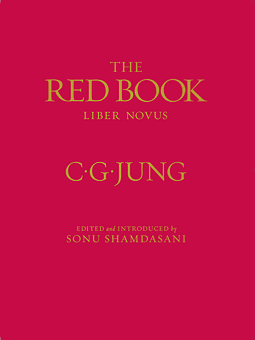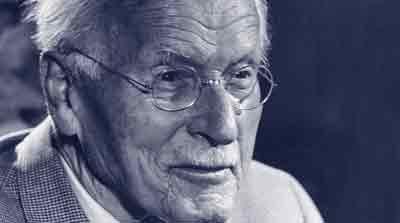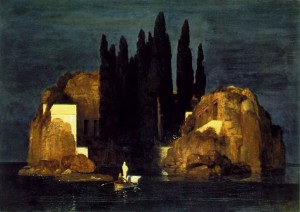Culture Vulture: Reading Jung’s “Red Book,” Part One
An examination of the the recent publication and translation (ninety years after it was begun) of C. G. Jung’s confessional meditation “The Red Book.” The volume stands in a select company of books that exerted an enormous influence on social and intellectual history even while it remained unpublished.
THE RED BOOK by C.G. Jung. Edited by Sonu Shamdasani. English translation by Shamdasani, Mark Kyburz, and John Peck. W.W. Norton & Co. 404 pages, $195.
By Helen Epstein
 I was intrigued in September to hear about the publication – ninety years after it was begun – of Carl Gustav Jung’s “Liber Novus” or the “Red Book.”
I was intrigued in September to hear about the publication – ninety years after it was begun – of Carl Gustav Jung’s “Liber Novus” or the “Red Book.”
I’m a student of memoir and his “Liber Novus” sounded like a 20th century contribution to an autobiographical genre that dates back to St. Augustine’s “Confessions” as well as a book of religious or spiritual revelation. Like Augustine and Dante, Jung experienced a profound break in his belief system or what we now call a mid-life crisis.
He had addressed it like many writers: making notes of his thoughts and feelings, reworking his notes into a narrative, showing it to friendly readers (including his wife, his lover, and several colleagues), revising it, having it typed and then – feeling ambivalent about exposing himself so candidly–consigning it to a drawer.
Except that he never entirely consigned it to a drawer. Instead, Jung used his raw material to build a body of psychology, drew on it for a succession of professional publications, and repeatedly showed parts of his “Liber Novus” manuscript to friends and colleagues.
He took it out again in 1959 – two years before he died – and in a handwritten Epilogue that breaks off in mid-sentence added:
“I worked on this book for 16 years. To the superficial observer, it will appear like madness. It would have developed into one, had I not been able to absorb the overpowering force of the original experiences. With the help of alchemy, I could finally arrange them into a whole. …I knew how frightfully inadequate this undertaking was, but despite much work and many distractions I remained true to it, even if another possibility …”
In its outlines, Jung’s process was like that of an artist. His practice of going into his study after a day of seeing patients and having dinner with his family, then inducing altered states of consciousness and writing down what he encountered in them is not that different from what most novelists and many memoirists do.
What was, of course, very different was the nature and scope of his project: Jung was wrestling with the Christianity he had grown up with, creating his own cosmology, generalizing his own inner conflict to the conflict between what he called “the spirit of the time” and “the spirit of the depths.”

C.G. Jung
Before consigning his text to a drawer, Jung rewrote it by hand onto folio-sized sheets of parchment, and then pasted them onto thick white pages that evoke the pages of medieval Gospel books like the “Book of Kells” or prayer books like “Les Très Riches Heures du duc de Berry.”
He did the Latin and German calligraphy himself, illustrating it with vivid, color-saturated miniatures and full-page paintings. He spent what must have been hours laboring over historiated initials – those highlighted first letters of a new verse or phrase illustrated to elaborate meaning.
Even though the book was going into a drawer, he commissioned a bookbinder to produce a volume of expensive red leather embossed with gold leaf to contain his lavishly illustrated folios.
It was that unusual mix of spiritual memoir tradition and sheer grandiosity that piqued my curiosity about the “Red Book”: the translation of visions into images as well as words, the deliberate evocation of The New Testament, the mix of medieval religious style and twentieth century psychology.
I also knew something about the controversies swirling around Jung: his intense attachment to and break-up with Sigmund Freud; his intense relationships and sometime sexual liaisons with a succession of women patients; his equivocal behavior during the second world war; his way of recycling and reworking what he wrote until anyone could take anything from it.
There were many people, I found, who agreed with Jung’s contemporary Walter Lippmann that the psychiatrist’s work was “ a personal adventure in search of a philosophy far more than a contribution to psychoanalytic understanding.” Others proudly called themselves Jungians.
So I ordered a copy of the book.
The volume that arrived on my doorstep measured 18 x 12.3 x 2.4 inches, weighed 9.6 pounds, and was 404 pages long. “The Red Book” was too heavy to hold in my lap for more than five minutes so I read it in small increments at my dining room table. And while I had my customary pencil in hand, I was surprised to find myself oddly reluctant to make any mark on the large and beautiful white pages.
About half of those pages are facsimiles of the original German and Latin calligraphy; the other half includes the English translation of “Liber Primus,” “Liber Secundus,” and “Scutinites,” and an extensive, wide-ranging introduction by Jung historian Sonu Shamdasani, a professor at the Wellcome Trust Centre for the History of Medicine at University College in London. He is also General Editor and co-founder of the Philemon Foundation outside of Philadelphia, which is engaged in publishing everything Jung ever wrote.
The images in the “Red Book” are museum quality and practically throb with color; the text, sometimes captivating, sometimes tedious, echoes the multitude of voices from sacred and secular literature that influenced Jung: Old Testament, New Testament, many eastern religious classics, Dante, Goethe, Nietzsche, Pascal, Swedenborg – to name just a few.
Shamdasani makes over one thousand footnotes, citing changes in the text and as many sources and influences that he can track down. Flipping back and forth between the original German, the art, the English text and those annotations I found myself disoriented and exhausted.
Although the “Red Book” is clearly the record of a spiritual crisis and the author’s repeated attempts to wrest meaning from it, much of its content seems to be more raw than integrated. Throughout, it seems that Jung tinkered with his story – insisting on the veracity of his time frame but, in fact, often collapsing time and creating composites, issues that are live controversies among writers of memoir today.
“The years of which I have spoken to you, when I pursued the inner images, were the most important time of my life,” reads a paragraph placed at the front of the “Red Book.”
It was written in 1957 – four years before he died — at a time he still felt it prudent to keep the object under wrap:
“Everything else is to be derived from this. It began at that time, and the later details hardly matter anymore. My entire life consisted in elaborating what had burst forth from the unconscious and flooded me liker an enigmatic stream and threatened to break me. That was the stuff and material for more than only one life. Everything later was merely the outer classification, the scientific elaboration, and the integration into life. But the numinous beginning, which contained everything, was then.”

Freud (L) and Jung (R): Jung had an intense attachment to and break-up with Sigmund Freud
In his comprehensive and valiant attempt at summarizing the contents and contextualizing Jung, Shamdasani argues that there can be few unpublished works that have ever exerted such influence on social and intellectual history. Jung, he writes, “played a central role in modern psychology, psychotherapy and psychiatry and a large international profession of analytical psychologists work under his name. His work has had its widest impact, however, outside professional circles.”
Words and terms Jung made popular — “introvert,” and “extravert,” “synchronicity,” “persona,” and “collective unconscious” have permeated popular culture. Writers, artists, performers, users of recreational drugs, and spiritual seekers of all stripes have been drawn to Jung’s explorations in expanding consciousness.
Herman Hesse was briefly one of his analysands and his “Steppenwolf” and “Magister Ludi” owe much to Jung, as do Doris Lessing’s novels, Federico Fellini’s films and Joseph Campbell’s research on comparative mythology and religions. Laurens Van der Post thought Jung was the only human being he had ever met “of whose greatness” he was certain, and wrote the memoir “Jung and the Story of our Time,” to show why.
C.G. Jung was born in 1875, the son of a poor, small-town pastor of the Swiss Reformed Church who ended every family dinner with a reading from Luther’s Bible. His parents’ marriage was an unhappy one and Carl grew up a solitary child with a much younger sister, given to ruminating about both his day and night dreams as well as his frequent visual hallucinations.
His mother and much of the maternal (Preiswerk) side of the family were as interested in parapsychology as his father was in the Protestant Church and their precognitive dreams, crystal gazing, trance states and séances were part of daily conversation. Jung also grew up frightened of Catholic priests and by 12, had lost faith in his father’s brand of religion.
As a child Jung believed that he had two distinct personalities. Personality #1 was the school boy who studied the subjects assigned by his rigorous gymnasium: the Greek and Latin classics, the German philosophers, literary masters, world history and science. Personality #2 was the boy who pursued his inner mysteries and communed with nature. That division was to imbue his life and writing.

Swiss painter Arnold Böcklin's Isle of the Dead
In 1895, he entered the pre-med program at the University of Basel, where he read the psychological works of William James and Richard von Krafft-Ebbing, whose “Textbook of Psychiatry” seemed to promise a way to blend his two personalities. While at university, he also studied literature and art. He was particularly influenced by the symbolic and mystical work of Swiss painter Arnold Böcklin. He also took part in many séances, some organized by a female cousin.
Shamdasani begins his introduction to the “Red Book” with a brief consideration of the “cultural moment” – the first decades of the twentieth century in Central Europe when psychologists, artists and writers lived and worked in more overlapping ways than now and shared an interest in the relatively new fields of comparative religion and folklore, the dissemination of literary and artistic artifacts from the East, occult phenomena, somnambulism, visions and fantasies. Many used “automatic writing,” in their quest for new forms and ways of perception.
Jung not only shared artistic ideas but would meet and treat some of Zurich’s artists and writers as his patients.
============================================
Helen Epstein’s essay on “Narrative in Memoir and Psychoanalysis” appears in this winter’s issue of “Psychoanalytical Perspectives” and in the newly published “Ecrire la Vie.”

i’d love to go to the ny exhibition of “the red book,” but no matter how much this work got to me it cdn’t totally lay to rest my unease with jung, who did, after dabble in antisemitism at exactly the wrong time to do do, & whose followers have tried to cover his tracks.
Helen Epstein is to be congratulated for writing a unusually objective article. I recently saw the exhibit where Jung’s Red Book is prominently displayed. Considering the extraordinary attention to detail it is a wonder he found the time to produce this work which is only a small amount of the enormous work he – like Freud – produced.
However when it comes to his ideas – particularly his partially psychodynamic and partially mystical/ magical theory of synchronicities I part company.
For those who would like to view an alternative naturalistic theory of synchronicities I invite you to read my soon to be published book (the result of a 40 year investigation of these most perplexing occurrences) called: DEMYSTIFYING MEANINGFUL COINCIDENCES (SYNCHRONICITIES): The Evolving Self, The Personal Unconscious, and The Creative Process.